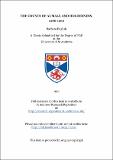Files in this item
The counts of Aumale and Holderness, 1086-1260
Item metadata
| dc.contributor.advisor | Adam, R. J. | |
| dc.contributor.author | English, Barbara | |
| dc.coverage.spatial | 2v [282, 504 p.] | en_US |
| dc.date.accessioned | 2018-07-12T09:40:50Z | |
| dc.date.available | 2018-07-12T09:40:50Z | |
| dc.date.issued | 1977 | |
| dc.identifier.uri | https://hdl.handle.net/10023/15292 | |
| dc.description.abstract | The counts of Aumale, who held the land of Holderness for two hundred years, came into England at the end of the Conqueror's reign. They came from Aumale in the north-eastern corner of Normandy, a small county grouped around a little town, a castle and a church. The counts lost their Norman lands in 1204, but kept their continental title until the last Aumale heiress, died in 1274. Holderness is a flat, low-lying and marshy district of eastern Yorkshire, between the River Hull and the sea. It has always been isolated from the rest of Yorkshire and England, by its river boundaries of Humber, Hull and Earl's Dyke. In the early middle ages it was of strategic importance in the struggle against Danish invasions, and the Conqueror, probably for this reason, treated Holderness as a special case, and instead of perpetuating the multiple tenancies of the Anglo-Saxon era, gave all the land there (except the church's fee) to his brother-in-law, Odo. The isolation of the district and the consolidation of land holdings in Holderness affected its development. The area became a highly privileged lordship, with many of the powers of the greatest palatinates of England. Holderness had, for instance, a private sheriff and a private coroner, and could exclude all royal officers except the justices of the eyre. Within the liberty (as it came to be called) there developed an efficient administrative system under a number of able men. Most of the counts' lands lay in Yorkshire. In Holderness there were only ten knights' fees, but they were of exceptionally large size, and some of the knights who in Holderness held one fee or less were elsewhere in England tenants-in-chief with many knights of their own. The revenues on which both counts and knights lived came from' the work of the ordinary people in their fields and pastures, and the counts too involved themselves in agriculture and particularly in sheep-farming. They also established three towns in Holderness, but only one (Hedon) proved successful. Like most of their contemporaries, they endowed many religious houses, the largest and richest in Holderness being Cistercian Meaux, founded in 1151 by William, count of Aumale, on the site of his hunting park. | |
| dc.subject.lcc | HC254.3H7E6 | |
| dc.subject.lcsh | England--Economic conditions--1066-1485 | en |
| dc.subject.lcsh | Normandy (France)--Economic conditions | en |
| dc.title | The counts of Aumale and Holderness, 1086-1260 |
This item appears in the following Collection(s)
Items in the St Andrews Research Repository are protected by copyright, with all rights reserved, unless otherwise indicated.

